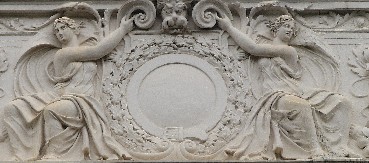 Pediment figures, Belgrave Square.
Pediment figures, Belgrave Square.
 Pediment figures, Belgrave Square.
Pediment figures, Belgrave Square.
Belgrave Square has several modern statues, a rare chance to see a collection of modern foreign figural work out of doors in London. The Square, together with Eaton Square, forms the centre of Cubitt's huge development on behalf of the Second Earl of Grosvenor in the 1820s, and is a complete and unspoilt example of his work. It is of prodigious size - 684ft x 637ft, a total of almost 10 acres.
First the sculpture. Four bronze statues are at corners of the central fenced square, and are by foreign sculptors:
Simon Bolivar, by Hugo Daini (Italian/Venezuela), and two of the panels.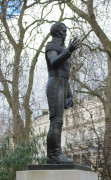
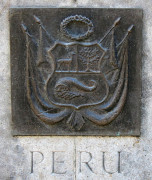
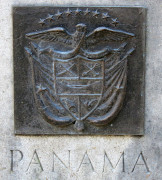
The statue of Simon Bolivar is signed 'DAINI', Caracas Venezuela, 1973. The sculptor Hugo Daini, though living in Venezuela, was Italian by birth. The statue has a modern treatment, formal, with over-sized chest, and little detail or character. At the base are little bronze coats of arms in relief of the countries whose fate he was connected with: Ecuador, Colombia, Bolivia, Venezuela, Peru, and Panama.
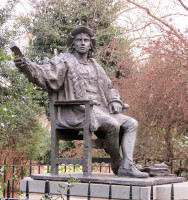
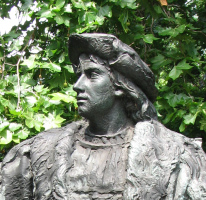 Christopher Colum,bus, by Tomas Banuelos.
Christopher Colum,bus, by Tomas Banuelos.
Much better as a sculptural work is the Christopher Columbus, a gift from Spain, left in rough textured bronze. The great explorer is shown seated in a chair, but occupying it as if it were a throne, one elbow resting on the chair arm, the other extended and holding a folded and tied map. He is shown as a young man, beardless, wearing a cap over long hair, all making him look rather the romantic hero. The statue was put up in 1992, and the sculptor was Tomas Banuelos.
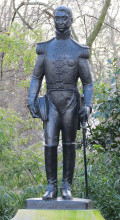 Don Jose de San Martin, by Juan Carlos Ferraro (Argentina).
Don Jose de San Martin, by Juan Carlos Ferraro (Argentina).
The Don Jose de San Martin, 'founder of Argentine independence and gave freedom to Chile and Peru', is dated 1993, the gift of the British community in Argentina, 1994. A stiff proud figure, again in rough bronze, with sketched in uniform. The affected style of the monument, with stiff collared-neck and bulging uniform over the chest, recalls early naive pictures of South American soldiers. The sculptor, from Argentina, was Juan Carlos Ferraro. There is a comparable statue of a South American struggler for independence on the corner of Fitzroy Square, near to the British Museum and Tottenham Court Road, in the bronze figure of General Francisco de Miranda, who was instrumental in the independence struggle of Venezuela.
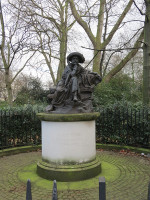
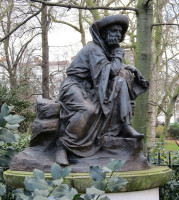 Henry the Navigator, by Simões de Almeida (Nephew).
Henry the Navigator, by Simões de Almeida (Nephew).
The fourth statue is of Prince Henry the Navigator, and as described at the unveiling of the statue in 2002, by the Portuguese President, 'It shows the Prince facing the sea, visualising the unknown world and bringing far-off lands within distance'. The sculptor is identified as Simões de Almeida; apparently this is the only statue of a Portuguese personage in London. There were two Portuguese sculptors called Jose Simoes de Almeida, uncle and nephew, and this was the work of the nephew, born in 1880, d.1950. The original statue was apparently made in 1915, and the Belgrave Square work would seem to be a modern edition. It is a serious sculpture, rather Edwardian in style, so far as one can make such comparisons. Prince Henry is shown wearing a wide brimmed hat, and enveloped in a robe which gives ample scope for carefully worked out drapes hanging ove rthe arms, upper body and legs. He rests on a rock, elbow on knee and with his hand supporting his chin, contemplating, the other hand outstretched on another rock, holding an unrolling scroll or map.
The central gardens of the Square are fenced off for use by residents, but we can see within, two further sculptures.
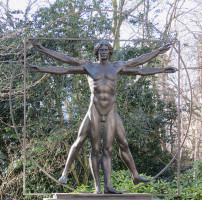 Enzo Piazotta's Homage to Leonardo.
Enzo Piazotta's Homage to Leonardo.
Homage to Leonardo, the Vitruvian Man, is a work by the Italian sculptor Enzo Piazzotta (1921-81), completed by his assistant Mark Holloway in 1982, and sponsored by Mr and Mrs John M Harbert III, of Birmingham, Alabama. It shows the very recognisable 8-limbed figure in a bronze circle. A serious work. There is other work by Enzo Piazzotta to be seen in London - the Young Dancer by the Royal Opera House in Bow Street is a particularly nice example. His also is the dancing man (Jete) on the Thames Embankment on the route between Pimlico Station and Tate Britain.
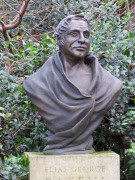
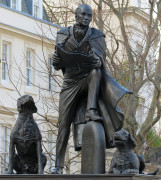 Jonathan Wylder's modern pieces: George Basevi and Sir Robert Grosvenor.
Jonathan Wylder's modern pieces: George Basevi and Sir Robert Grosvenor.
So much for the foreign sculpture. We also have two modern pieces by the British sculptor, Jonathan Wylder. The first, to be glimpsed within the fenced central area, is a bronze bust of George Basevi, the architect of Belgrave Square, on a stone plinth. It shows him enveloped in a piece of drapery which covers the base of the piece, and is in a modern idiom. The second, at the corner of Wilton Crescent is a statue Sir Robert Grosvenor himself, with a Ruskin quote: 'When we build let us think we build for ever.' A lively pose, two dogs, and good texture, though some conventionality in treatment of the hair. It's date is 1998. The whole ensemble is an encouraging sign of the quality of unmannered figural work that still goes on in modern times.
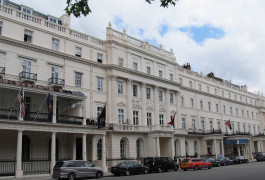 Part of one side of Belgrave Square.
Part of one side of Belgrave Square.
The architecture, as noted above, is by Basevi working for Thomas Cubitt, and is complete around the Square. Four great ranges of neo-Classical terraces in brick with stucco, with many Corinthian pillars, and projecting centres as an opportunity for decoration. These have pots or jugs on top, to give an interesting skyline, with decoration below. The side with the lowest numbers has pots and a decorative frieze to the centre, and has been under scaffolding for an interminably long time. The centres of the other three sides are more ornate:
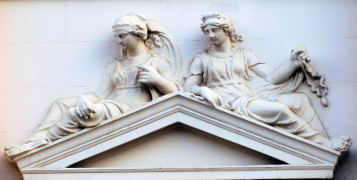
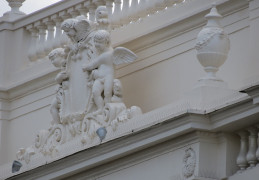 Sample ornamental figures from around the terraces.
Sample ornamental figures from around the terraces.
The detached mansions at the corners were the work of other architects - no.12 is pictured on the page on this site on Robert Smirke. No. 37, in the South East corner, the largest house in the Square, is Seaford House, named after Baron Seaford (Lord Howard de Walden, who lived there in the 1900s, and which passed to Government ownership in WW2, becoming what became the Defence Academy of the United Kingdom. The architect of this building was Philip Hardwick. Alas, no sculpture on this great block of a building.
The Grosvenor family was descended from the chief hunter to the Dukes of Normandy before the Conquest, and became immensely rich from mines in the north, and later as landlords. The Belgravia area had been a marshy one, with a topsoil of clay, which Cubitt removed, made bricks from, and so exposed the underlying gravel on which to build. 'Belgrave' was a lesser title of the Earl of Grosvenor, and so the Square was named. There are lots of embassies there now - the earliest one in the Square was the Austrian one in the 19th Century, but there is at least one artistic connection of great interest to these pages: Chantrey, the sculptor, had a house (actually two of them knocked together) at the corner of Eccleston Street.
We end by noting that around Belgrave Square and the streets running off it are various bits of extra ornateness and the odd sculptural addition, including the examples below.
North East along Grosvenor Crescent to Hyde Park Corner // Eastwards along Belgrave St to Victoria Station
Visits to this page from 13 Mar 2014: 16,471